Maricevic Fine Art — one of Moscow´s leading art galleries, is proud to present a new project devoted to the great traditions of realism in Russian art, with a particular focus on the 1960s generation of artists. The years of the Khrushchev era, also known as "the thaw", witnessed the emergence of many of the greatest names of Soviet art: Victor Ivanov, the Tkachev brothers, Valentin Sidorov, Alexei Gritsai, Andrey Kurnakov and Gely Korzhev. It is these same distinguished artists whose works are now on show in a special exhibition within the framework of the Moscow World Fine Art Fair.
In the 1960s in Russia, on the stage of the fine arts, there was a whole group of artists who, despite the immense difficulties of the post-war era, the oppressive atmosphere of the totalitarian state and the influence of rigid propaganda, managed to find a path, not explicitly opposed to authority, nor wholly breaking the formulas prescribed by the state, but yet which allowed them to create great art: an art of spirit and with a quality of workmanship comparable to the most outstanding examples of the Russian classical school of the XIX century.
Filled with vitality, bright color and expressive style these men of the Sixties were, on the one hand, a direct continuation of the traditions of the "Wanderers" and Russian realism, and on the other hand incorporated all that was best of the impressionists and the most significant artists of the Russian avant-garde. This art formed a silent opposition to the official "utopian" direction in Soviet painting, serving, as it did, communist propaganda and the practical purposes of the state´s authority.
Many are inclined to explain the poor quality and explicit politicization of official Soviet art by arguing that the artists were constantly compelled to shut their eyes to real life and to conjure up within themselves a state of "euphoria", somehow sincerely believing in those subjects they represented in their work: Alexander Samohvalov with his portraits of idealised Soviet women, on which were modeled the heroines of the 1970s films that dealt with the themes of the pre-war years, Alexander Gerasimov with his grandiose pictures representing Stalin in the Kremlin or those with Stalin and Voroshilov at the Teheran conference, and a great many other artists working to the requirements of an era of Soviet holidays and with subjects on industrial themes — all of them were "victims" of time and of the rigid dictatorship of authority.
Everything changed with the Second World War which brought to this country not only unimaginable suffering, but also a great spiritual awakening and a wave of patriotism which revived Soviet art that was largely in decline. The energy of a new creative impulse profoundly affected the artistic culture of those years, acting as a catalyst for the rapid realization, even the blossoming of a considerable new direction in the fine arts whose nucleus was formed by the masters of the "severe style". Alongside them worked representatives of the older generation, such as A.A.Plastov, A.A.Deineka, J.P.Kugach, B.V.Joganson, etc. All of them were united in the aspiration to strive for the truth; the desire to express, as far as possible, more precisely the ideas and moods of their contemporaries and to show man in all the completeness of his spiritual manifestations, to embody the beauty of wild nature in unity with the life of the country and her people.
The works of the brothers Sergey and Alexey Tkachev, Victor Ivanov and Valentin Sidorov presented by Maricevic Fine Art, along with those by Gely Korzhev, Alexey Gritsai and Andrey Kurnakov, are unique, with a timeless significance and expressiveness of the true classics. The work of the majority of artists in this group bears that characteristic imprint imposed during the era of the Second World War. Sergey Tkachev and Andrey Kurnakov both served on the front and so have known their share of the national suffering, but at the same time, they found that invaluable human experience which has fundamentally influenced their ideological and creative development. The younger artists, who did not receive this baptism of fire, still lived and grew up among those people singed by the war. The beliefs of those front-line soldiers, their sober, independent judgments on current affairs and problems served for the creative youth as a reference point in their search for the truths of life and art and helped them to find the right standards by which to judge events and to realize the true needs and aspirations of national life.
The fashion which has endured over the last decade for the classics of XIX century, and in particular for the works of the "Wanderers" has somewhat overshadowed the merits of these no less outstanding masters of the realistic school of the XX century — frequently the direct pupils and spiritual followers of those former generations. For this reason, up until recently the very existence of "other" Soviet art, lacking grandiosity and hypocrisy has unjustly gone unnoticed by a significant section of the general public.
Each of the painters whose work is presented by Maricevic Fine Art has a unique place in art and is a vivid, original artist who was born out of the circumstances of an astounding era. They are artists belonging to a generation of masters who forged a path to a new realism in the twentieth century, continuing the great tradition of depicting the world in its true form and original beauty. Thanks to their untiring aspiration towards freedom and its source, their search for truth and beauty in, seemingly, simple things there was made, in those years, a vivid and enduring mark in the history of the growth of Russian art culture, whose echoes we feel to this very day. Today we have a unique opportunity to pay homage to the talent of these artists, trained in the traditional fashion and continuing, despite old age, to work productively to this day, keeping the tradition which has long brought glory to the Russian school of painting.
Maricevic Fine Art
Russian Art of XIX—XX centuries.
Consultations on the West-European painting from Old Masters up to Impressionism.
Russia, Moscow, 1-st Obydenskii pereulok, 8
Phone: +7-495-290-43-83
Phone / fax: +7-495-290-49-12
Email: maricevic@gmail.com
www.maricevicfineart.com
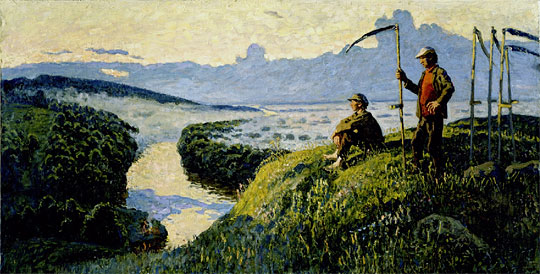
"Homeland. On the ancient Vshizh" 1982 — 1985
Oil on canvas, 105 x 205 cm
Tkachev Sergey Petrovich (b. 1922) and Tkachev Alexey Petrovich (b. 1925) are outstanding artists and genre painters, who have worked together already for more than fifty years. The art of Tkachev brothers first developed in a traditional manner. However simply copying from nature held no interest for them and so emerged their unrestrained, expressive and richly textured style of painting which established a clear distance between the photographic perception of reality and art itself. Their art is focused on the life of simple people, and they do not present events with intriguing plots, but rather ordinary daily life with its domesticity. The Tkachev way of painting creates a vigorous and joyful mood with its brave spirit, glinting on the surface of the water, and vigorous, short and wide brush strokes, which mould female figures.
This landscape, one of the most widely known canvasses of the Tkachev Brothers, is the highest point in the creative endeavours of the Tkachev brothers. It was painted near their homeland in the Bryansk region. On such a scale with so luminously bright a work an all-embracing image of Russia is expressed in its essence, in its genuine form. This Homeland had been defended by the senior brother, Sergey Tkachev during the war when he was a soldier and was seriously wounded. The brothers like to celebrate all their anniversaries on this hill, to put out tables, spread table cloths, invite guests and enjoy a true celebration. "There are three versions of this picture. One is a pure landscape, which is in the Bryansk museum. Another is in the State Russian Museum — an incomplete composition (it does no show the river, the temple and only one of the heroes). And this, the third version, already with the lake, and with the river Desna, more beautifully defined and composed in a masterly fashion and by far the biggest of the three", Sergey and Alexey Tkachev, speaking about the work, say. "We come from the simple people, from their very core: this is why the most important thing for us is our love of Russia, of its people".
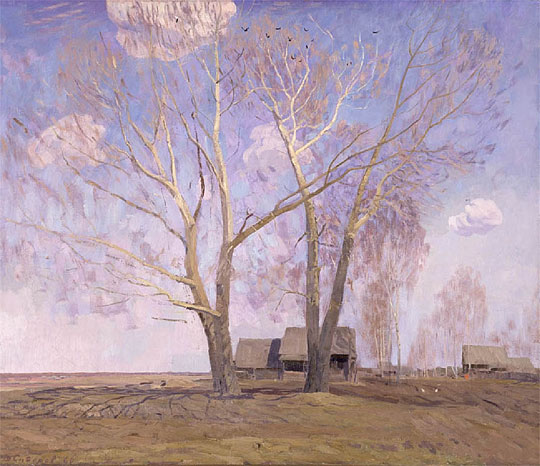
"Spring. High skies" 1960
Oil on canvas, 102 x 120 cm
Sidorov Valentin Mihailovich (b. 1928) the talented painter and chairman of the Union of Artists of Russia. "To convey the feeling of your homeland is far from simple, but how grateful we are to those painters who have such a talent. "Valentin Mihajlovich Sidorov is undoubtedly such an artist" writes Gely Korzhev. "There is a deeply felt compassion and empathy for his homeland which affects us subtly from his canvases". It may seem that in Russian landscape painting everything has already been said. Venetsianov, Savrasov, Shishkin, Levitan and the landscape painters of the time closer to us — Rylov, Krymov, Turzhansky and others had not left space for the expression of a fresh, original perspective on the Russian landscape. Valentine Sidorov has proved, that nature is inexhaustible for the expression of all kinds of new and unexpected visions. His technique is deceptively simple: there is no complex layering of paint, little texture, it all appears discouragingly direct. But in this simplicity lies the secret. These works are simple in execution and conceptually but strikingly truthful and full of emotion.
Present work, holding warm memories of youth, is of great personal significance to the artist. "That spring I received a letter from a girl I loved, and that same evening the radio broadcast Rakhmaninov´s second concerto and all these deep emotions came together. And the spring was a joy of sunshine. Profound feelings filled my soul. I had taken my notebook in the morning, put on my boots and set off for the sun: to search for those places which had inspired Levitan in his picture "Spring. High water" - my favourite landscape, small in size, but immensely emotional, — says Valentin Mihajlovich. — So I came to the village of Alekseevskoe, I looked and saw huge poplars and a flock of black rooks flying towards its upraised branches against the bright blue sky. And yet higher was a sky full of clouds. What an image! It was as though I was hearing Rakhmaninov´s music again and an "eternal" hymn to nature. Those clear days lasted for a long-long time".
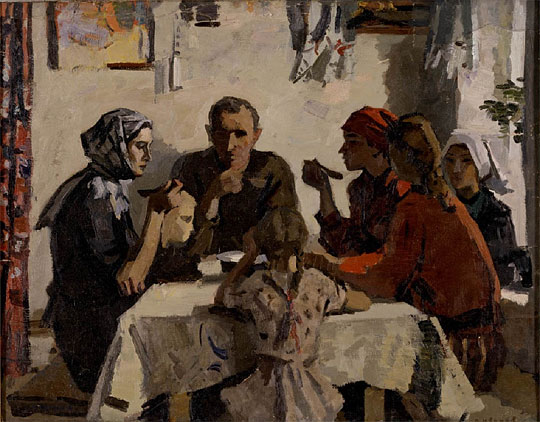
"Family. 1945" 1958 — 1964. Sketch.
Oil on canvas, 86 x 67 cm
Victor Ivanovich Ivanov (b. 1924) — was one of the founders of the "severe style" in Russian painting. The Ryasan area where his mother was born became the main inspiration of his art and the object of a spiritual attachment. There he sought inspiration, and all of his most powerful images were born there. In the village, all human life was there from the first day till the last. The artist saw in this place the truest merging between man and nature, redemption of a kind, and the preparation for the peace of eternity. He saw the monumental and yet romantic greatness of country work and life. Simple village objects in Ivanov´s pictures become meaningful symbols of rural life, measured and at the same time somehow eternal. All this attains a sense of the highest solemnity and creates an atmosphere of deep significance, an intense emotional envelope. "Our art was magnificent, we created works which it seemed to us, did not distort reality in any way, — Victor Ivanovich recalls. — This was the Truth of our time and this Truth has always been most important for my art. I believe in realism. It gives us strength, speaks of beauty both physical and moral. Realism is the highest art; history shows nothing to equal it".
This work is a sketch for one of Victor Ivanov´s most well known paintings "The Family. 1945", created during 1958-1964 and on display today in the permanent exhibition of the State Russian Museum in Saint Petersburg. Its history is very interesting. Just after the war, the artist was visiting a simple house in the village of Red Yar where many Old Believers lived. It was there that he met a front-line soldier, his wife and three daughters, all full of life. This above all is victory! "It seems to me, that it is one of my best pictures: here is both the soviet era, and the more immediate time: the Russia of the post-war period," so claims Victor Ivanovich himself — "I wanted somehow to convey that sensation of the end of the war. The poverty was horrifying, but life itself was of a unity. What could possibly speak more of a victory than that moment when a man has returned from war and sits together with his family in his own home? I chose to paint a picture representing the essence of human life - bread, land, peace".
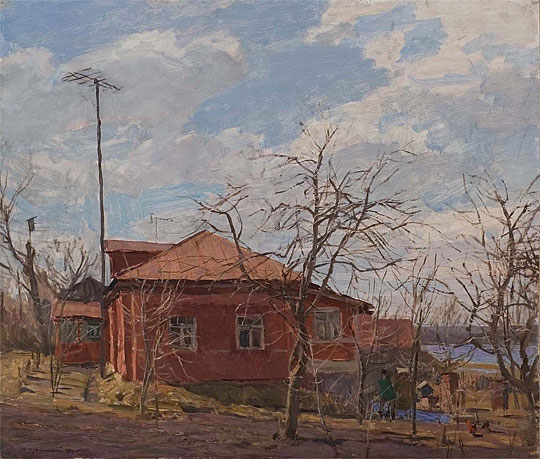
"Red house" 1973
Oil on paper and cardboard, 59 x 69,5 cm
Alexey Mihajlovich Gritsai (1914 — 1998) — an artist of the Leningrad school, demonstrates in his pictures the lyricism of Pushkin´s time in the image of Russian nature he captures: here are simple and lucid moments from life. Alexey Gritsai has often spoken with deep seriousness of the painting of landscape and has paid great attention to the smaller scale and the sincerity of his compositions, in counterbalance to the cult of monumentalism widespread in the Soviet era. For the artist nature is deeply connected to the personal, which is why genre motives are so naturally a part of his landscapes.
Alexey Gritsai has devoted many of his works to the theme of spring. It took the artist several years in order to finally capture that special spring mood: the feeling of a joyous event. The soft color palette of the landscape radiates energy from within which strikes one with the depth and saturation of its tones and conveys a clearly perceptible emotion. In this work Alexey Gritsai wanted more than anything to convey that "quivering" condition of nature, "when the green has yet to come, but a special light falls on the ground and there is the imminence of spring´s changes in transparent, light air", and for Gritsai this was clearly achievable.
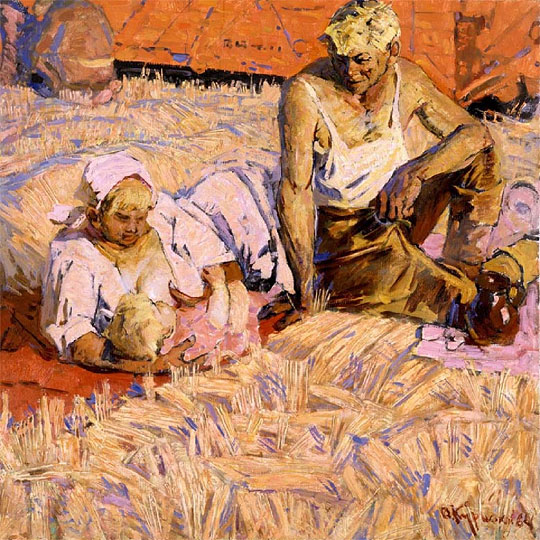
"Harvest" 1966. Right part of a triptych "Earth"
Oil on canvas, 70 x 70 cm
Kurnakov Andrey Ilych (1916, Oryol) a lyrical artist and a man of difficult destiny, he was captured fighting the Germans, founded his own school of painting in his native Oryol. As professor of the Oryol state university, A. I. Kurnakov has brought up more than one generation of painters, graphic artists and teachers of fine arts. His art is devoted to the same beautiful lands that were so close to the heart of the Russian writer Turgenev. "The basis of my art is nature and the person within her. I paint only that which the soul accepts, as is only true and right for an artist. With each picture I should first live through each picture and imagine what it will be". Thus speaks Andrey Ilych of his own work. This love of his homeland acts as a rejuvenating spring for the inexhaustibly artistic youthfulness of this Artist, his life affirming work and truly Russian art.
"Harvest" — the right part of the triptych "Earth" is luminous and vibrant, filled with the hope of new beginnings. The artist set out to create the image of a man, a hard worker who has lived through the war. Andrey Kurnakov has always avoided "clichés" in art. This is not an image of Soviet man, idealized by propaganda. "Each hero in my works is a unique person who at all times retains his individuality. Only then will the portrait conjure up genuine emotions", so says Andrey Ilych.
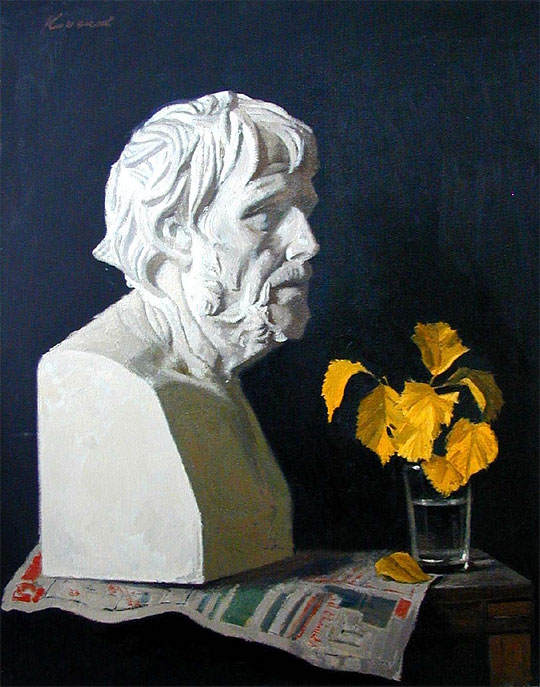
"Seneca" 1989
Oil on canvas, 100 x 89 cm
Gely Mihailovitch Korzhev (b. 1925) — a man of spirit, living "genius" of the Soviet era. Each of his canvasses is a truly profound and independent work of art. Contrary to opinion of many eminent art historians; he never thought of himself as an artist of the "severe style". This style was initiated by Petrov-Vodkin and Deineka, rather than by us!", says Korzhev. He has refused two awards in the post-perestroika era, calling himself "an artist of socialist realism". "A man of a complex, many-faceted character: he has the clear mind of the philosophers of the past. Tall and bearded he has a likeness to Socrates. "He is almost too imposing to speak with". Say his friends, the artists Sergey and Alexey Tkachev. The work of Gely Korzhev is very popular in the west these days where it is frequently exhibited and sought after by collectors.
In a series of "Antique" still-lives at the end of 1980-s and the beginning of the 1990-s the artist has represented men and women´s plaster masks and antique marble busts. "Still-lives allow me a good opportunity to work out the approaches to well balanced composition", says Gely Korzhev. In them I consciously seek the most favorable point of view on a subject. Subtle contrasts bring a focus to subjects, and so the articulation of their most essential details". This work represents a sculpture of a Roman politician and philosopher: the stoic Seneca in an ideal image of the wise man who is spiritually independent and has overcome human passions.